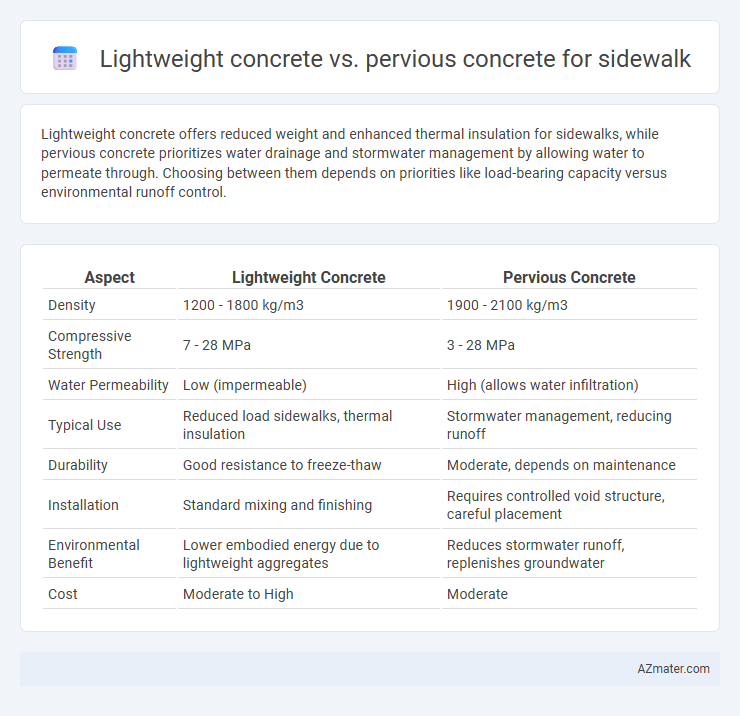Lightweight concrete offers reduced weight and enhanced thermal insulation for sidewalks, while pervious concrete prioritizes water drainage and stormwater management by allowing water to permeate through. Choosing between them depends on priorities like load-bearing capacity versus environmental runoff control.
Table of Comparison
| Aspect | Lightweight Concrete | Pervious Concrete |
|---|---|---|
| Density | 1200 - 1800 kg/m3 | 1900 - 2100 kg/m3 |
| Compressive Strength | 7 - 28 MPa | 3 - 28 MPa |
| Water Permeability | Low (impermeable) | High (allows water infiltration) |
| Typical Use | Reduced load sidewalks, thermal insulation | Stormwater management, reducing runoff |
| Durability | Good resistance to freeze-thaw | Moderate, depends on maintenance |
| Installation | Standard mixing and finishing | Requires controlled void structure, careful placement |
| Environmental Benefit | Lower embodied energy due to lightweight aggregates | Reduces stormwater runoff, replenishes groundwater |
| Cost | Moderate to High | Moderate |
Introduction: Comparing Lightweight and Pervious Concrete
Lightweight concrete, known for its reduced density and enhanced thermal insulation, provides durability and ease of handling for sidewalks in urban and residential areas. Pervious concrete offers high permeability, allowing water to pass through efficiently, reducing runoff and supporting groundwater recharge in sustainable sidewalk designs. Comparing these materials highlights their distinct advantages in strength, water management, and environmental impact for optimized sidewalk construction.
Composition and Material Differences
Lightweight concrete for sidewalks typically incorporates lightweight aggregates such as expanded clay, shale, or pumice, reducing density while maintaining structural integrity and thermal insulation. Pervious concrete composition includes a high content of coarse aggregates and minimal fine aggregates, creating a porous matrix that allows water infiltration and reduces runoff. The key material difference lies in lightweight concrete's emphasis on low-density aggregates for durability and insulation versus pervious concrete's design for permeability through interconnected voids.
Strength and Durability Analysis
Lightweight concrete offers enhanced strength-to-weight ratio and better thermal insulation but may have lower compressive strength compared to pervious concrete, which is designed for high permeability and effective stormwater management. Pervious concrete typically shows lower durability under freeze-thaw cycles and heavy traffic conditions, while lightweight concrete demonstrates superior resistance to cracking and long-term structural integrity. For sidewalks, selecting between these concretes hinges on balancing the need for load-bearing strength with drainage requirements and environmental exposure.
Permeability and Drainage Capabilities
Pervious concrete offers superior permeability and drainage capabilities compared to lightweight concrete, allowing water to pass through its porous structure and reduce surface runoff on sidewalks. Lightweight concrete typically has lower permeability due to its denser composition, limiting its effectiveness in water management applications. The enhanced permeability of pervious concrete helps mitigate flooding risks and promotes groundwater recharge, making it a preferred choice for sustainable sidewalk construction.
Installation Methods and Workability
Lightweight concrete for sidewalks offers ease of installation due to its reduced density, enabling quicker handling and less labor-intensive placement compared to traditional mixes. Pervious concrete requires careful mixing and placing techniques to maintain its porosity, necessitating skilled workmanship to ensure proper aggregate distribution and compaction without clogging voids. Workability in lightweight concrete is enhanced by optimized mix designs with admixtures, while pervious concrete demands precise water-to-cement ratios to preserve permeability and structural integrity during installation.
Environmental Impact and Sustainability
Lightweight concrete reduces environmental impact by incorporating recycled aggregates and requiring less raw material, which lowers carbon emissions during production. Pervious concrete enhances sustainability through its porous structure, allowing stormwater infiltration, reducing runoff, and promoting groundwater recharge. Both materials contribute to eco-friendly sidewalk construction, but pervious concrete specifically addresses urban water management and mitigates flooding risks.
Cost Comparison: Material and Maintenance
Lightweight concrete typically incurs higher initial material costs due to specialized aggregates like expanded clay or shale but offers reduced maintenance expenses because of its enhanced thermal insulation and lower susceptibility to cracking. Pervious concrete, while often more affordable in raw materials, demands consistent maintenance to prevent clogging and ensure permeability, potentially increasing long-term costs. Evaluating total lifecycle expenses, lightweight concrete may prove more cost-effective for sidewalks in regions requiring durability and minimal upkeep, whereas pervious concrete is advantageous for stormwater management but can incur higher maintenance costs.
Slip Resistance and Safety for Pedestrians
Lightweight concrete offers improved slip resistance for sidewalks due to its textured surface and reduced density, enhancing pedestrian safety by minimizing falls. Pervious concrete excels in drainage, preventing water accumulation and reducing slick surfaces, which significantly lowers the risk of slipping. Both materials provide safety benefits, but pervious concrete is particularly effective in wet conditions by allowing water to pass through, maintaining a dry, slip-resistant surface.
Suitability for Various Climate Conditions
Lightweight concrete offers excellent thermal insulation properties, making it suitable for colder climates by reducing heat loss and minimizing freeze-thaw damage on sidewalks. Pervious concrete excels in warm and rainy environments by allowing efficient water drainage and reducing surface runoff, which prevents puddling and ice formation in mild winters. Both materials enhance sidewalk durability but require climate-specific considerations to optimize performance and longevity.
Best Applications: Choosing the Right Concrete for Sidewalks
Lightweight concrete is ideal for sidewalks requiring reduced structural load and improved thermal insulation, making it suitable for pedestrian areas in elevated or sensitive environments. Pervious concrete offers superior stormwater management by allowing water infiltration, preventing runoff and reducing urban flooding, which is essential for sidewalks in regions with frequent rainfall. Selecting the right concrete depends on whether load reduction or porous drainage is the primary requirement for the sidewalk's application.

Infographic: Lightweight concrete vs Pervious concrete for Sidewalk
 azmater.com
azmater.com